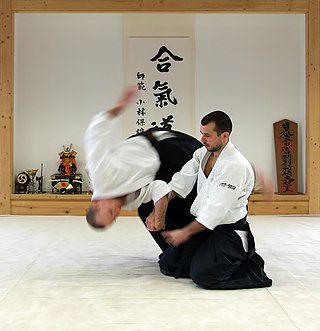
Aikido is a modern Japanese martial art which is split into many different styles including Iwama Ryu, Iwama Shin Shin Aiki Shuren Kai, Shodokan Aikido, Yoshinkan, Renshinkai, Aikikai, and Ki Aikido. Aikido is now practiced in around 140 countries. It was originally developed by Morihei Ueshiba, as a synthesis of his martial studies, philosophy and religious beliefs. Ueshiba's goal was to create an art which practitioners could use to defend themselves while also protecting their attackers from injury. Aikido is often translated as "the way of unifying (with) life energy" or as "the way of harmonious spirit". According to the founder's philosophy, the primary goal in the practice of aikido is to overcome oneself instead of cultivating violence or aggressiveness. Morihei Ueshiba used the phrase masakatsu agatsu katsuhayabi" to refer to this principle.
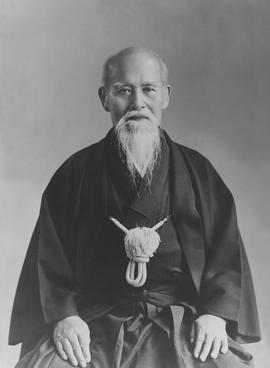
Morihei Ueshiba was a Japanese martial artist and founder of the martial art of aikido. He is often referred to as "the founder" Kaiso (開祖) or Ōsensei (大先生/翁先生), "Great Teacher".

The Aikikai is the original school of Aikido. It is centered on the Aikikai Foundation in Japan, and its figurehead is the Doshu. It is represented globally through the International Aikido Federation.
Morihiro Saito was a teacher of the Japanese martial art of aikido, with many students around the world. Saito's practice of aikido spanned 56 years, from the age of 18, when he first met aikido founder Morihei Ueshiba, until his death in 2002.
The Iwama Dōjō is a dōjō built by the founder of aikido, Morihei Ueshiba, who lived there from 1942 until his death in 1969. It is located in the former town of Iwama and became an important historical location for the development of aikido and "a Mecca to the aikido community." This dojo is also where Morihiro Saito, one of the founder's closest students, learned and taught aikido from 1946 until 2002 developing what is often referred to as the Iwama Style.

Koichi Tohei was a 10th Dan aikidoka and founder of the Ki Society and its style of aikido, officially Shin Shin Toitsu Aikido, but commonly known as Ki-Aikido.
Gozo Shioda was a Japanese master of aikido who founded the Yoshinkan style of aikido. He was one of aikido founder Morihei Ueshiba's most senior students. Shioda held the rank of 9th dan Aikikai and 10th dan of IMAF aikido.

Michio Hikitsuchi was an aikido instructor and was the chief instructor of the Kumano Juku Dojo, in Shingu, Wakayama Prefecture, Japan, for fifty years.
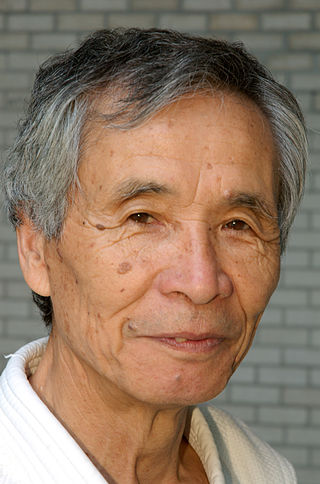
Nobuyoshi Tamura was a prominent aikidoka and a direct student of Morihei Ueshiba. The son of a kendo teacher, Tamura entered the Aikikai Hombu Dojo in 1953 as an uchi-deshi of aikido founder Morihei Ueshiba. He was one of Ueshiba's favorite pupils and since 1964 has greatly contributed to the development of aikido in Europe and France in particular. He was the National Technical Director (DTN) of the FFAB. He held the rank of 8th dan and the title of Shihan. Throughout his teaching career he trained many others instructors in various countries around the world but foremost Western Europe. In 1999, he received the medal of "Chevalier de l'ordre National du Mérite" from the French government. Tamura published several books on aikido in French. His dojo, Shumeikan Dojo, is located in the village of Bras, France. His former students include Jorge Rojo Gutierrez, Toshiro Suga, Pierre Chassang and Alain Peyrache.
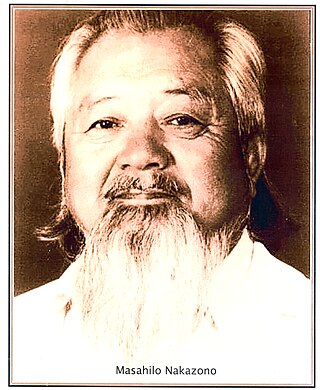
Mutsuro Nakazono ) was a Japanese acupuncturist, an Oriental medicine practitioner, a judo 6th dan and a 7th dan Aikikai aikido master. He studied under Morihei Ueshiba and Ogasawara for many years. Born in the Kagoshima prefecture of Japan, he relocated to France in 1961 where he remained until the early 1970s as a representative of the Aikikai in Europe and North Africa. According to an article by his son, Jei Atacama, Mutsuro Nakazono "changed his name to Masahilo Mikoto Nakazono in his late fifties when he came to realize how his whole life was about his pursuit for 'the truth of life.' 'Masahilo' stood for 'searcher for the beautiful truth of life.'" During this period he was also Chief instructor of Aikido for the international Budo Council. According to Henry Ellis, a pioneer of UK Aikido, Nakazono Sensei's Aikido technique was "the first seen in the U.K. to combine the power found with other instructors, with the grace normally associated with Aikido today." He operated the Nakazono Clinic, a natural healing center in San Diego, California. He moved to Santa Fe, New Mexico in 1972 and lived there until his death in 1994.
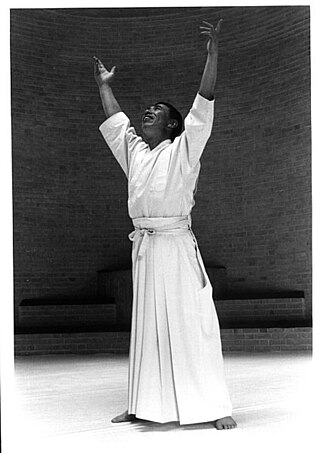
Masamichi Noro is the founder of Kinomichi and was an uchi-deshi of Morihei Ueshiba, the founder of Aikido.
Seiseki Abe was a Japanese shodo and aikido teacher who had a unique relationship with aikido founder Morihei Ueshiba, being both his student in aikido and his teacher in calligraphy.
Bansen Tanaka was a Japanese aikido master and a pre-war and post-war disciple of aikido founder Morihei Ueshiba.

The Aikido Schools of Ueshiba (ASU) is a not-for-profit Aikido organization founded by Mitsugi Saotome Shihan upon moving from Japan to the United States in 1975. It is a federation of about 110 Dojos throughout North America.

Hirokazu Kobayashi was a Japanese aikido teacher and student of the founder of aikido Morihei Ueshiba. In 1970, at the age of 41, he was awarded 8th dan rank. He is the initiator of Kobayashi aikido (国際合気道研修会小林裕和派).
William Gleason is the American author of two books about aikido, spirituality and kototama. He holds the rank of 7th dan in aikido and is the founder and head instructor of Shobu Aikido in Somerville, MA, USA. Gleason teaches seminars worldwide.
Hiroshi Kato; was an Aikido Master. He lived in Tokyo, Japan, and travelled the world teaching the principles of Aikido. A former student of Morihei Ueshiba, Sensei Kato taught from 1986 onwards in his Dojo "Suginami Aikikai" located in the Ogikubo district of Tokyo and has over 55 students.
Alan Ruddock was an Irish Martial Arts pioneer, teacher and writer. He introduced both Aikido & Karate to Ireland and was the founder of the Aiki no Michi and its interpretation of Aikido. Ruddock was one of the few western Aikido practitioners and only Irish national who studied directly under the founder of Aikido, Morihei Ueshiba ("O-Sensei").

Stanley A. Pranin was an American martial artist, founding publisher, and editor-in-chief of Aikido Journal. Pranin, a researcher and archivist of aikido, has written and published several books and many articles about aikido, Daito-ryu Aikijujutsu, and Morihei Ueshiba and was an influential figure in the aikido world.












